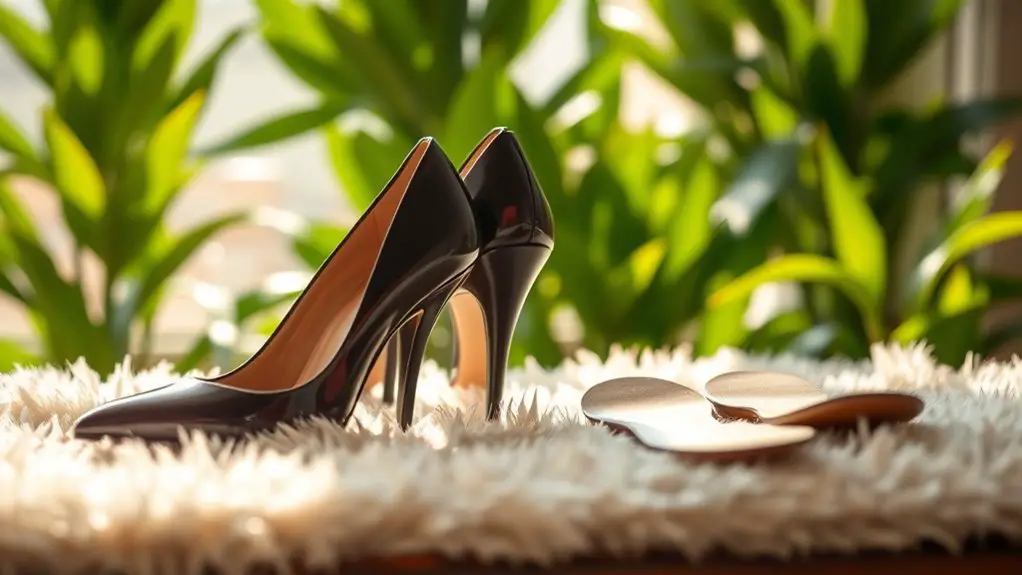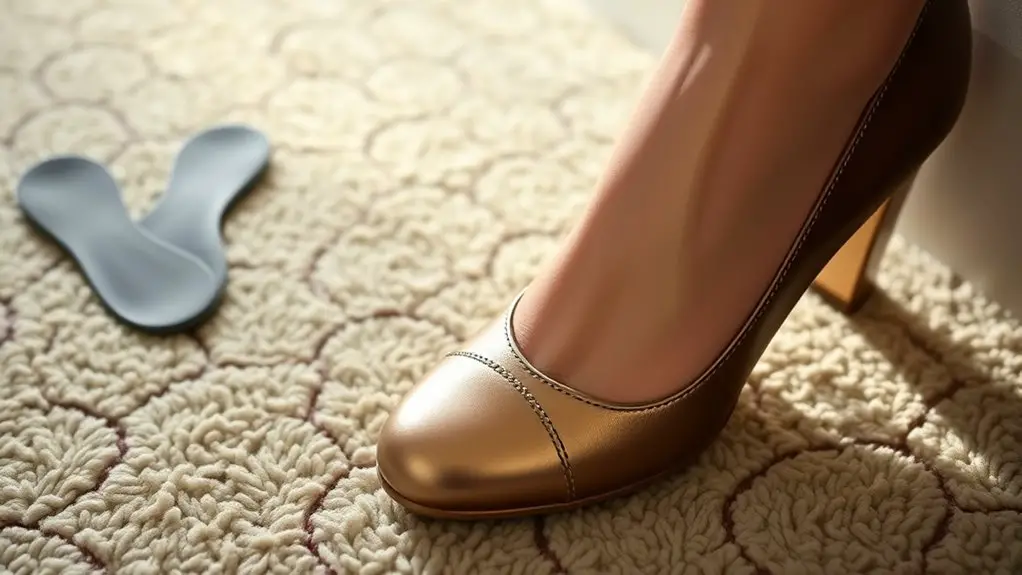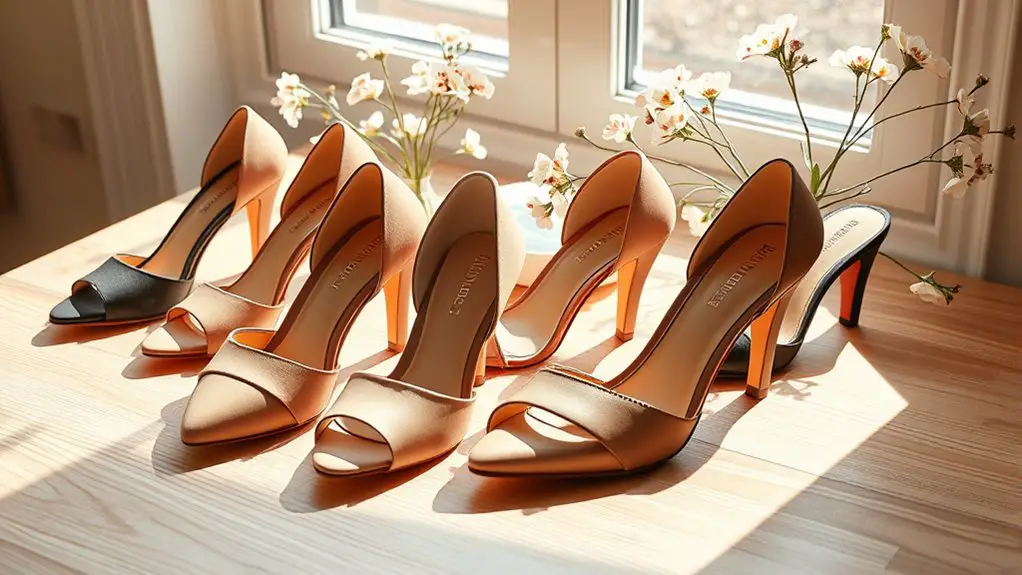Yes, there are heels designed to help with foot arch pain. Look for styles that incorporate proper arch support, cushioned insoles, and a firm heel counter for stability. Block heels and wedges are also beneficial, as they distribute weight more evenly. Brands like Clarks and Vionic offer ergonomic designs that prioritize comfort. If you’re unsure, there are tips and alternatives available that can enhance your experience wearing heels. Discover more about supportive options and features that alleviate discomfort.
Understanding Foot Arch Pain

Foot arch pain is a common condition that can greatly impact daily activities and overall quality of life. You might experience this pain due to various causes, including plantar fasciitis, overuse, or improper footwear. Understanding these causes is vital for effective management. Treatment options often include physical therapy, stretching exercises, and the use of orthotic devices tailored to your foot structure. You may also benefit from rest and ice application to reduce inflammation. In some cases, anti-inflammatory medications can aid in alleviating discomfort. If your pain persists, consulting a healthcare professional is important for a thorough evaluation and personalized treatment plan. By addressing the root causes of your arch pain and exploring appropriate treatment options, you can improve your mobility and enhance your overall well-being. Remember, early intervention can lead to better outcomes in managing foot arch pain.
The Importance of Arch Support
Arch support plays an essential role in maintaining foot health and alleviating discomfort. It provides stability, distributes weight evenly, and can greatly reduce pain associated with foot arch issues. Understanding the different types of arch supports and recommended shoe features will help you make informed choices for best comfort and support.
Benefits of Arch Support
When it comes to maintaining overall foot health, proper arch support plays a critical role in alleviating discomfort and preventing injury. Understanding the arch support benefits can enhance your daily activities and improve your quality of life. With effective arch support, you can experience improved posture, which reduces strain on your lower back and enhances overall alignment.
| Arch Support Benefits | Impact on Health |
|---|---|
| Pain Relief | Eases discomfort in feet |
| Improved Posture | Supports spine alignment |
| Enhanced Stability | Reduces risk of falls |
| Increased Comfort | Allows for prolonged wear |
Incorporating arch support into your footwear can lead to significant improvements in your foot health and overall well-being.
Types of Arch Supports
While many may overlook the importance of proper arch support, it plays an essential role in maintaining foot health and overall comfort. There are various arch support types designed to address different foot conditions. Rigid orthotics provide substantial support for flat feet or high arches, while flexible insoles offer moderate cushioning for those with mild discomfort. Gel inserts are another option, providing excellent heel cushioning and shock absorption, which can alleviate pressure during movement. Additionally, custom-made supports can be tailored to individual foot shapes for maximum benefit. Selecting the appropriate arch support type can greatly reduce pain and enhance your walking experience, ensuring your feet remain healthy and comfortable throughout the day.
Recommended Shoe Features
Selecting the right footwear is essential for supporting foot health, particularly when it comes to managing arch pain. To alleviate discomfort, prioritize shoes that feature adequate arch support, which can be achieved through specific shoe materials and heel designs. Look for cushioned insoles made from breathable and flexible materials that conform to your foot’s shape, offering both comfort and stability. Additionally, opt for shoes with a heel design that promotes proper alignment, such as a slight elevation to reduce strain on the arch. A firm heel counter can also enhance support and prevent excessive foot movement. By focusing on these features, you’ll create an environment that mitigates arch pain and promotes overall foot health.
Types of Heels With Arch Support
Choosing the right type of heel can greatly alleviate foot arch pain, especially when you prioritize arch support. Various heel styles can provide support without sacrificing aesthetics. Here’s a comparison of effective options:
| Heel Type | Arch Support Level | Heel Materials |
|---|---|---|
| Wedge Heels | High | Cork, wood, rubber |
| Block Heels | Moderate | Leather, synthetic |
| Platform Heels | Low | Foam, rubber |
| Kitten Heels | Moderate | Suede, leather |
| Pump Heels | Variable | Patent leather, canvas |
Opt for wedge and block heels for superior arch support, as these styles distribute weight evenly. Stylish options like platform and kitten heels can also provide relief if chosen wisely. Always consider heel materials, as they can affect comfort and durability.
Features to Look for in Supportive Heels

When selecting supportive heels, it’s vital to take into account the arch support design, as it directly impacts your foot’s alignment and comfort. Additionally, adequate cushioning and shock absorption are essential to minimize impact and enhance overall wearability. Finally, heel height plays a significant role in maintaining proper posture and reducing strain on your arches.
Arch Support Design
Finding the right heels for arch support can greatly impact your comfort and foot health. When selecting supportive heels, focus on arch support materials that provide stability and resilience. Look for options made from high-quality foam or gel, which conform to the shape of your foot while offering adequate support. Ergonomic designs are also essential; they should promote proper alignment and distribute weight evenly across your foot. Features like contoured footbeds and built-in arch supports can enhance your overall experience. Make sure that the heel height is moderate to reduce strain on your arches. By prioritizing these elements, you can find heels that not only alleviate discomfort but also improve your posture and foot health over time.
Cushioning and Shock Absorption
Cushioning and shock absorption are critical features to evaluate in supportive heels, as they play a significant role in reducing impact on your feet during daily activities. When searching for heels, focus on cushion materials that provide adequate softness and support. Look for options that incorporate gel or foam technologies, as these materials can enhance comfort and alleviate pressure on your arches. Additionally, shock absorbing soles are essential for minimizing the force transmitted through your feet with each step. Heels designed with these features can help prevent exacerbation of foot arch pain, allowing you to maintain your routine without discomfort. Prioritizing cushioning and shock absorption will contribute to overall foot health and improved mobility.
Heel Height Considerations
Selecting the right heel height is essential for those experiencing foot arch pain. A lower heel height, typically around one to two inches, is generally recommended as it promotes better foot alignment and reduces strain on the arches. Heels that exceed this height may exacerbate your discomfort by forcing your foot into an unnatural position, leading to increased pressure on the plantar fascia. Look for shoes with a slight heel lift that still allow for adequate arch support, as this can enhance overall foot comfort. Additionally, guarantee the heel provides a stable base to prevent excessive movement within the shoe. By prioritizing heel height and support, you can mitigate arch pain and improve your overall walking experience.
Brands Known for Comfortable Heels

When you’re dealing with foot arch pain, choosing the right heel can greatly impact your comfort and overall well-being. Many brands are known for providing stylish options that don’t compromise on comfort. Here are a few comfortable brands to take into account:
| Brand | Notable Features |
|---|---|
| Clarks | Arch support and cushioned footbeds |
| Naturalizer | Ergonomic designs and flexible soles |
| Vionic | Built-in orthotic technology |
These brands have prioritized comfort without sacrificing style, making them ideal choices for your footwear needs. Clarks offers a range of heels with excellent arch support, while Naturalizer focuses on ergonomic designs. Vionic stands out with its built-in orthotic technology, providing additional relief for foot arch pain. By selecting from these reputable brands, you can ease your discomfort and still look fashionable.
Tips for Choosing the Right Pair of Heels
Finding the right pair of heels is essential for those experiencing foot arch pain. Start by considering heel styles that provide adequate support and stability. Opt for wider heels or block styles, as they distribute weight more evenly, reducing pressure on your arches. Look for shoes with a cushioned insole, which enhances foot comfort and absorbs shock during walking.
Pay attention to the arch support; some heels come with built-in arch support, which can greatly alleviate discomfort. Additionally, choose a shoe with a lower heel height to minimize strain on your feet. Materials also matter—breathable fabrics can prevent excessive sweating and discomfort.
Finally, make certain you select the appropriate size; shoes that fit well can prevent unnecessary friction and pressure, further aiding your foot comfort. By considering these factors, you can make a more informed choice for your heel selection.
How to Break in New Heels Safely
Although breaking in new heels can be uncomfortable, taking the right approach can minimize pain and prevent injury. Start by wearing your heels for short periods, gradually increasing the duration as your feet adjust. This method employs effective breaking techniques that help your feet acclimate without excessive stress.
Consider using safe materials like padded inserts or gel cushions to enhance comfort and reduce pressure points. These additions can alleviate arch pain and provide better support. When trying on your new heels, walk on various surfaces to assess flexibility and stability.
Avoid wearing them for extended periods, especially on hard surfaces, as this can exacerbate discomfort. Finally, remember to listen to your body; if you experience persistent pain, it’s essential to reassess your choice of heels. Properly breaking in your new footwear can lead to a more enjoyable experience while safeguarding your foot health.
Alternatives to Traditional Heels
For those seeking comfort without sacrificing style, exploring alternatives to traditional heels can be beneficial. Stylish alternatives such as block heels, wedges, and low-heeled shoes often offer the elevation you desire while providing greater stability and support. These options typically feature supportive designs that incorporate cushioning and arch support, which can alleviate foot arch pain.
Consider shoes with adjustable straps or built-in arch support, as they enhance fit and comfort. Brands specializing in comfort footwear also offer chic designs that align with current fashion trends, ensuring you don’t have to compromise on aesthetics.
Additionally, flats and fashion sneakers with elevated soles are becoming increasingly popular, merging comfort and style seamlessly. By opting for these alternatives, you can maintain a polished look while prioritizing your foot health, ensuring that your footwear choices enhance rather than hinder your overall well-being.
Real-Life Testimonials: Comfort and Style in Heels
How do real people navigate the challenge of balancing comfort and style in heels? Many individuals share personal experiences that highlight the importance of choosing stylish options without sacrificing foot health. One user reported discovering a brand that offered heels with arch support, which transformed her experience at social events. She noted that these heels not only alleviated discomfort but also complemented her outfits beautifully.
Another individual emphasized the value of adjustable straps, which provided better foot stability while maintaining a fashionable appearance. Customers frequently mention that incorporating cushioned insoles into their favorite heels can greatly enhance comfort, allowing for extended wear.
These testimonials demonstrate that it’s possible to enjoy stylish footwear while addressing foot arch pain. By prioritizing supportive features and making informed choices, you can find heels that keep you comfortable and fashionable, making each step enjoyable.
Frequently Asked Questions
Can Wearing Heels Worsen Existing Foot Arch Pain?
Wearing heels, especially certain heel types, can worsen foot arch pain due to altered foot alignment. High heels often elevate the heel, increasing pressure on the arches, potentially exacerbating any existing discomfort or pain.
Are There Specific Heel Heights Recommended for Arch Support?
When considering heel height recommendations, shoes with a moderate heel height of 1 to 2 inches often provide ideal arch support. Higher heels can increase pressure on the arch, potentially exacerbating discomfort and pain.
How Often Should I Replace Supportive Heels?
Every 6-12 months, you should replace supportive heels, especially if you’re wearing them frequently. Replacement frequency varies depending on heel materials; synthetic options may wear faster than leather, affecting overall support and comfort.
Do Insoles Work With Heels for Arch Pain Relief?
Insoles can greatly enhance heel comfort, providing arch support that alleviates pain. Their benefits include improved alignment and shock absorption, making them a viable option for those seeking relief while wearing heels.
Can Heel Type Affect Overall Foot Health Long-Term?
Choosing heels is like selecting the right tool; heel structure can greatly impact your foot health. Poor choices may lead to long-term effects, including pain and misalignment, affecting overall mobility and comfort. Prioritize wisely.



